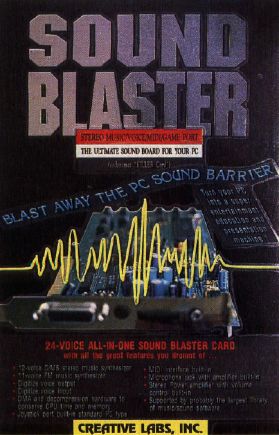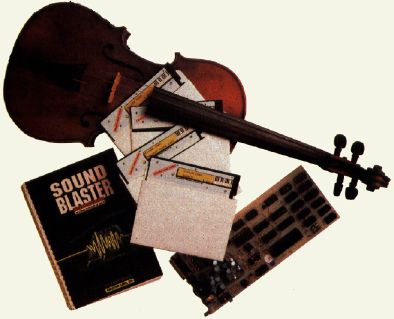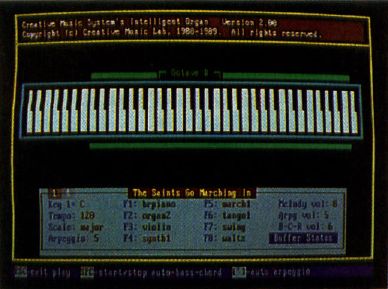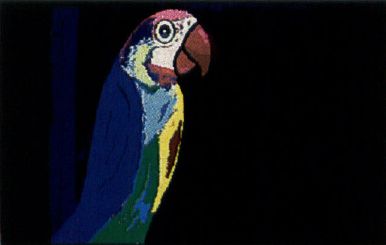ENTERTAINMENT

COMPUTE! CHOICE
RICHARD C. LEINECKER
BLAST THE PC SOUND BARRIER WITH THIS CREATIVE CARD
And now a moment of silence for the PC sound critics. With Creative Lab's Sound Blaster card, IBM-compatible computers have taken the lead in sound and music for personal computers. This single board replaces your PC's beep with 24 separate voices: Eleven of those voices offer 100-percent compatibility with software designed for the Ad Lib music card; 12 are compatible with Creative Labs' Game Blaster software; and the remaining voice replays digitized sound. All these features on one card would be enough to satisfy anyone looking for a dynamite PC sound card, but there's much more.
If your PC setup looks like a kitchen in an Italian eatery, with spaghetti wiring drooping to the floor, you'll appreciate the card's built-in amplifier. It eliminates the need for an external amp and the related wires, cords, and cables. The company has also squeezed a microphone jack (for recording digitized sound) and a MIDI interface onto the back of the card. Rounding out the long list of extras is a joystick port—a real boon for gamers.
Inserting the card into your PC is easy if you carefully follow the simple installation instructions. The Sound Blaster prototype I worked with took me just five minutes to install. (Straight from Singapore, it was one of the first in the country, and there were still some temporary wire bridges visible.) Once I had positioned the card, I was ready to take it for a test drive. Because I suffer from the common "manual-aversion" disease, I opted for an immediate acid test: running the opening of Space Quest III. I've listened to this Sierra soundtrack many times on both my Roland MT-32 and Ad Lib cards, and I knew the Sound Blaster would have to live up to some pretty powerful hype. It did.
My speakers aren't the traditional Bose models heard at trade-show demonstrations, but what I got from my setup was extraordinary. None of the aesthetics of a full-blown movie score were lost. Rich, full bass voices laid down the fundamental lines, while instruments thick with harmonics and subtle sonorities wove an accompanying fabric. Energetic percussion drove with impending direction, and exciting melodies came out clearly above it all.
Spurred on by my success, I pulled out every game I had with Ad Lib or Game Blaster sound support. Several were downright disappointing; they sounded like my seven-year-old 8-bit computer. Others, thankfully, had sound as superb as Space Quest III. I hope that programmers who support the enhanced sound devices of this card do so to the maximum extent; otherwise they're selling short.
Satisfied with the card's performance with commercial entertainment packages, I went on to explore the Sound Blaster's music-composition attributes using the company's Creative Music System (CMS) software designed especially for the Game Blaster card. Although the hardware capability is present, the CMS package isn't very sophisticated with respect to instrument timbre; however, the aural effect was still quite good. I switched over to Ad Lib's Visual Composer and, in minutes, had created superb-sounding charts.
Phillips screwdriver in hand, I spent the next several hours swapping cards and comparing them. Besides perhaps setting a new speed record for installing cards, I came to respect the Sound Blaster as a true breakthrough for the PC. The Roland MT-32 definitely has an edge (and a much higher price tag), but not so the Ad Lib and Game Blaster cards.

Thanks to well-planned hardware compatibility, Ad Lib and CMS software provide a large library of available software. But even better is the fact that programs can now simultaneously combine the 11 Ad Lib voices, the 12 CMS voices, and a digitized component for some terrific audio. Creative Labs aptly illustrated these possibilities on several demos it supplied with the card.
The first demo raised a voice from my computer: "You ain't seen nothing yet. You ain't heard nothing yet," it repeated. Behind the words an increasing fervor grew, with music and arcade-style sounds mirroring the action of graphics images. (The rotating spaceships were amateurish, but they did get the point across.) This particular demo used all 24 voices, and although the music and sound effects were simple in nature, the overall effect was impressive.

Another demo animated a lip-syncing parrot with digitized sound. A human voice sped up to simulate a parrot's voice provided a glimpse of the card's audiovisual potential. Another digitized demo had two recordings on disk that sounded as good as my stereo and allowed me to change the replay rate and create vastly different effects. The playback quality rivaled any digitized sound I've heard on other personal computers.
A disk of sound effects completed my orientation to the Sound Blaster. Gongs, cars, and brooks accompanied animated graphics.
Aside from its impressive software demonstration, Creative Labs has gone the last mile toward maximizing hardware performance. Not only do the Ad Lib and CMS voices operate as always, but a direct memory access (DMA) chip relieves the processor (for the most part) from the overhead of updating registers from the buffer. Translated, that means your computer can play music and make sounds without slowing down other processing tasks. While your computer runs an application, the DMA chip goes directly to memory and fetches the data. The DMA chip works effectively with digitized data, too.
Recording (or sampling) digitized sound on the Sound Blaster is easy. Just plug in an audio signal (a microphone, stereo, or tape player, for example) and then start and stop the recording from a menu in the card's Voice Kit software. Of course you can't store more data than you have memory for. After you've finished, simply tell the software to replay what you've stored. You can also save your recording to disk.
The Voice Kit program let me digitize at a variety of speeds ranging from 5 to 13 kilohertz (kHz). The hardware itself can sample at rates from 4 to 25 kHz, but the demo software didn't utilize the full range. Less memory is used at the slower speeds, but quality suffers; at the higher speeds the opposite is true—more memory is consumed and the quality is much better. I found, however, that the playback sounded good even at slower speeds. I also created some very interesting effects by speeding up and slowing down the playback speed.
By including hardware-based compression handling, the card's designers are able to save on the amount of memory you need to compose and record. Just how much memory does digitized sound use? At a 5-kHz sampling rate, 64K is eaten up in about 13 seconds. If you maximally compress this, then about 26 seconds' worth of sound data will fit in 64K. You can see how sampling sounds soon fills memory and disk space. Many games that boast digitized sounds optimize by using sounds at different speeds for different effects, which saves considerably on disk space and RAM requirements.
The Sound Blaster has two different types of compression: One packs 50 percent more data into memory with a moderate effect on quality, and the other stores 100 percent more information into memory with a greater effect on quality. Because packing your data significantly affects the sound, you might not want to compress your grand masterpiece.

The sound cababilities are enough to put this card with the leaders of the pack, but its added game port is a great bonus. My PC joystick worked fine; I didn't have any compatibility problems. Price a game card sometime and you'll see the value this one feature adds to the card.
The MIDI interface isn't as easy to use as the joystick port, but its inclusion reflects the serious intent Creative Labs has for offering a single product for a variety of uses. In order to plug in your MIDI instruments, you'll first have to get a special MIDI box from the manufacturer. The box plugs into the card's joystick port. (There's a joystick port on the box itself, so you don't lose the game-control feature.) On the box there are one MIDI-in and three MIDI-out receptacles, making it more useful than the single-plug capacity that I had anticipated.
One other caveat with respect to the card's MIDI capabilities: If you have MIDI software, it won't work with the Sound Blaster. The company is currently trying to standardize MIDI input and output for all software, but until that happens, be advised of this limitation.
A great enhancement to PC sound, with Ad Lib and Game Blaster compatibility, Sound Blaster is wonderful. But when will commercial software take advantage of all that the card has to offer? That's hard to guess, but Creative Labs is doing an admirable job of facilitating developers.
Technical information is readily available for programmers who want to support the card. Creative Labs makes a driver available free of charge. Further, the company can provide an object module for integration into programs where the extra driver file is undesirable.
There are several reasons for such strong company support. Most obvious is the anticipated profits from wide acceptance of the product. Second, Creative Labs claims it wants to achieve a set of compatibility standards for PC sound that will make things easier for everyone—developers and consumers alike. We can only hope that such a standard will arrive in time to prevent the many divergent paths that other PC peripherals and cards have experienced.
Although tools exist for the creation of data files for Ad Lib, Game Blaster, and digitized sounds, there's no single integrated tool for all three. I wish Creative Labs had taken care of this one detail.
With solid support from Creative Labs, developers should soon be writing programs that take advantage of the card. A representative from Sierra told me that the company plans on supporting the card with its new releases. That's good news from one company, and good news for consumers if other companies follow suit.
There is life after games, of course, and the Sound Blaster lends itself to those applications quite well. For education, hypermedia, and aid to the handicapped, new sound capabilities for the PC are a welcome and sorely needed addition. Packages like Optimum Resource's The New Talking Sticky Bear Alphabet inspire children to learn. With the availability of the Sound Blaster, your PC can become an effective educational tool on par with the best in the business—provided software companies make the effort to develop supportive programs.
In business and in education, hypermedia presentations that incorporate sound and graphics can become a powerful demonstration of the PC's effectiveness. In addition, speech and advanced sound enhances the PC's usefulness for the disabled.
The Sound Blaster accentuates the attractiveness of its features with a reasonable, if not groundbreaking, price. Listed at $239, the card could be discounted to under $200 by larger computer retail outlets. If you were to total the retail prices for the separate components, the advantage of this one-card solution becomes clear: Ad Lib card, $ 195; Game Blaster card, $130; joystick port, $40; MIDI interface, $200; digitizer, $90. The sum is $655, almost $420 over the price of the Sound Blaster, which includes all of these features.
Add to that the software that Creative Labs plans to bundle with the card (Intelligent Organ, the talking-parrot demo, and the Voice Kit), and a Sound Blaster purchase is even harder to resist. About the only accessories that you'll have to buy are a microphone for recording and the MIDI box, if that's your interest.
A company representative has said that Game Blaster owners will be able to upgrade to the Sound Blaster for $100 and the return of their Game Blaster card. Such a generous upgrade plan will go a long way toward establishing Sound Blaster in the market.
If you want to pursue avenues that require good-quality speech and sound from your PC, whether it be recreation, education, or productivity (such as desktop presentations with sychronized sound), then this one card can quite capably meet all those requirements. For PCs, old beep and boop just got their walking papers.
|
Sound Blaster CREATIVE LABS |